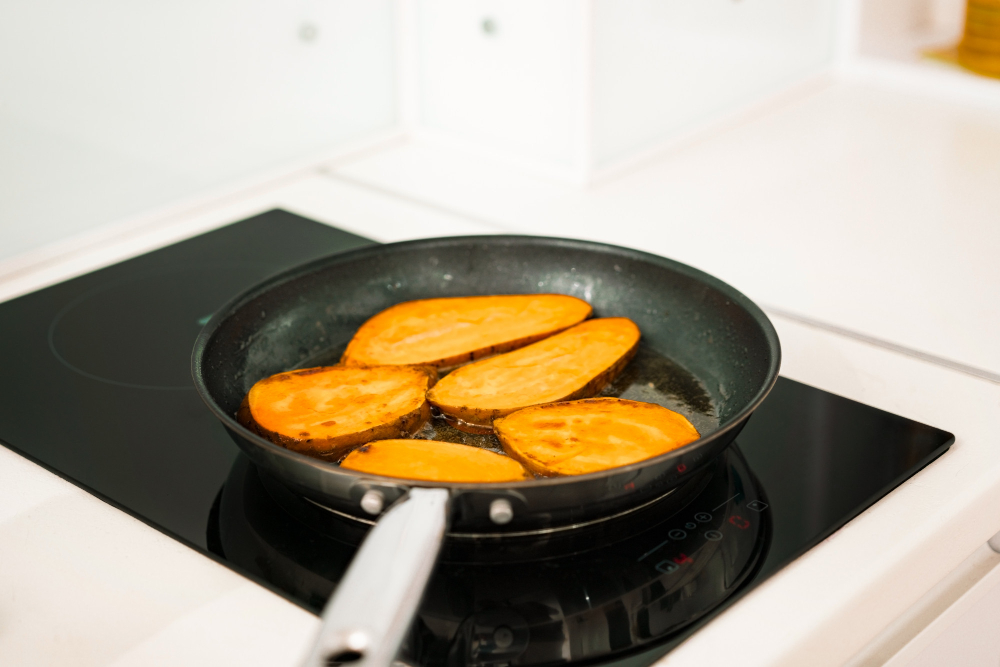Just bought an induction cooktop but couldn’t use it? It’s possible you bought the wrong pan type if you can’t use your new induction cooktop with some of your new pans.
The induction hob’s ring will not light with a conventional pot or pan. For induction cooking, a pan must be constructed of ferrous metal or have a ferrous metal base; therefore, this is the case.
Once the hob ring is turned on and ready to heat, the pan is used. The hob won’t recognize that a pan has been positioned if it contains any ferrous metal. This answers the question, “can you use induction pans on gas,” too.
Magnetic frying pans are required for usage on induction ranges. A magnetic field circuit is formed as soon as the hob picks up on this magnetic field.
Unlike a gas or electric stove, an induction hob uses electrical induction to heat a pan rather than thermal conduction. As a result, heat is generated when the correct pan is placed on an induction stove, and an alternating current is run through it.
Nothing happens because no magnetic field is generated when a standard pan is used on an induction burner. The result is that there is no heat being emitted.
Using a magnet to see if the pan or pot is magnetic can tell you if it is compatible with an induction hob.
All you must do is stick a magnet to the pan’s bottom. If the magnet sticks, the pan’s base is a ferrous metal and can be used on an induction stove. The answer is no, and it won’t.
What Happens If You Use a Regular Pan on an Induction Hob?
Induction hobs can be tricked by making them believe that your pans are magnetic. It would help if you used an induction hob converter to convert your regular pan to induction-friendly cookware.
The induction converters allow you to cook with non-induction pans on an induction cooktop without a problem. Use these for tiny pans that magnets can’t turn on under your hob.
The converter disc sits on top of your induction stove and generates the magnetic field necessary for induction cooking. You then place your pan on top of this disc and cook your food using the heat.
You may not get the maximum benefit of the power of a large hob ring if you use a converter that is too small for the size of the hob ring. However, with these discs, you can cook with a wide variety of appliances on your induction hobs without breaking the bank.
However, a large converter on a tiny pan can impair the induction hob’s energy efficiency. To put it another way, if a portion of the converter isn’t in contact with the pan, you’ll be wasting energy in your kitchen.
To maximize your energy efficiency when using a converter, you should buy as many converters as you can locate. Using this method, you may match the converter’s size to the pan you’re cooking to ensure that the heat is evenly distributed throughout.
What Happens When You Use Non-Induction Pans on Induction Hob?
Using regular pans without magnetic properties on an induction hob will have no effect. For induction cooktops to work, they must be used with magnetic pans.
If you use an induction hob with a pot made of glass, copper, or aluminum, the pans will remain chilly. Because of this, you’ll need to purchase magnetic cookware or a converter disc to cook appropriately on an induction cooktop.
Induction cooktops can only be used with pans with a flat bottom part of ferrous substances, such as cast iron or stainless steel. This is because magnetic properties can only be found in ferrous metals containing iron.
The magnetic field cannot travel through the base of the pan, so there is no electric current in the pan, which is what causes the pan to heat up. However, if you put them on an induction stove, they will remain cold.
The induction hob requires a magnetic pan to generate heat, which isn’t present in standard pans. Cooking requires an electric circuit and a magnetic field, which your stove generates.
Your conventional pots and pans will not function on an induction surface. Hold a magnet up to the cookware to see if it’s compatible with your induction cooktop.
Other options include purchasing converter discs to use your regular pans on an induction hob. All these possibilities may be found online, and the selling page of the brand should specify whether or not their cookware is induction compatible.
Can You Damage an Induction Hob by Using Wrong Pans?
If there is no magnetic contact between the pan and the induction cooktop, it will not work. Your induction hob’s surface can be permanently damaged if you use too thick or thin cookware or are not magnetic.
Instead of heating, the hob induction cooking uses a direct method of heating the pan. As a result, it responds as quickly as gas and is as accurate as electricity.
The copper wire induction coils create the magnetic field beneath the hob that heats the cooking surface. Using a pan with a magnetized base causes the pan to heat up immediately on the hob.
Humming, chirping, and whistling are all sounds that can be heard when the hob is turned too high, depending on the type of cookware. However, these noises are barely audible if the heat is lowered down during cooking.
All induction-ready pots and pans have flat bases. Cooking in pans with curved bottoms, like some woks, will yield poor results.
It is possible to get induction-friendly versions of these pans, however. For example, a cast iron wok with a flat bottom is ideal.
If your pan has a coil sign on the base or a magnet adheres firmly to its underside, it is suited for induction cooking. However, a pan may not heat as efficiently if the magnet is weakly attached to the base.

